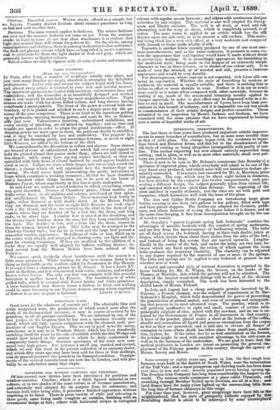PARIS FASHIONS.
(From our own Correspondent.)
In Paris, after Lent, a number of weddings usually take place, and just now many families are deeply absorbed in arranging the delightful preliminaries. Ladies who understand the subject begin with the linen, and almost every article is trimmed in some new and tasteful manner. The innermost garments are loaded with insertion, valeneiennes lace, and embroidery ; and the stomacher is so beautifully designed and worked that it can scarcely be matched by the most magnificent collars. Night dresses are made with lay-down frilled collars, and long sleeves having wristbands a mousqu.etaire. The front of the gown is covered with em- broidery, or it is plaited and stitched to such a degree as to try the pa- tience of the poor sempstress. There is no limit to the luxurious getting up of petticoats, morning dressing gowns, and sauts de lits so fashion- able just now. Valenciennes insertion, embroidered medallions, and every variety of stitching, are all mixed up together ; and no time and tumble are spared in order to attain the grand desideratum—effect. If dressing gowns are worn open in front, the petticoat should be entablier, and it may be enriched by lace and embroidery. The peignoir is a variety of the dressing gown, and sometimes festoons, or seven or eight little flounces, are added to the bottom of the skirt.
We cannot describe tho diversities in collars and sleeves. Some sleeves are formed of rows of embroidered teeth which fall over and appear to hold the plaited riband that passes under them ; others are half closed or fan-shaped; while many have zig-zag ruches interlaced, or they are sprinkled with little bows of riband fastened by small square buckles of coral or stceL Collars are worn a little larger, and not so high round the throat ; a change which all will appreciate now the warmer days are coming. We shall never finish enumerating the pretty inventions in linen, which constitute a wedding trousseau; all that we have described and a hundred other things besides, are to be seen at the house of Madame Payan, whose superiority in this line is quite undisputed.
At mid-Lent we noticed several toilettes in which everything wintry was quite discarded. Dresses of Chambery gauze China muslin, and India crepe Esse, in all qualities and colours, purchased at that splen- did establishment the M aison Delislc. These materials look lovely at night, either flounced or with double skirts. At the liaison Delisle they are flounced, and the seven or eight little flounces are each edged with a flat blonde, and they are carried up the skirt in the form of 'py- ramids, where they are finished off by a bow like the dress, and long ends, or by silver tags. A similar bow is placed at the shoulders, and the sleeves reach halfway down the arm, but they hang considerably at the back. The boddice is low, and a fiehu like the dress, crosses in front for women, behind for girls. This fichu may be arranged in the Charlotte Corday style ; but the tie in front and the large bow present a somewhat careless appearance. Medallions of tulle or lace, filled up in the centre with riband, and arranged in slanting rows, are light and ele- gant for evening trimmings. If they are modified 1:13, the addition of a ruche they are equally well adapted for taffetas walking dresses ; in- deed several from the Mahon Delisle have been noticed at the Tuileries.
We cannot speak decidedly about headdresses until the season is a little more advanced. While waiting for the new designs there is no- thing so fashionable as the coiffure called La Permission de Dix Heures. It is copied from a charming picture by M. Giraud. It has a Louis XV. point in the front, and it is ornamented with cerise, seabions, and reddish- brown velvet leaves. The only cap that can compete with this graceful invention is another named 1,a Fiancée. The foundation is of white puffed tulle, which is covered with Easter daisies and white primroses. A loose bandeau of tiny flowers forms a diadem in front, and nothing could be more becoming to our Parisian women, among whom regularity


























 Previous page
Previous page